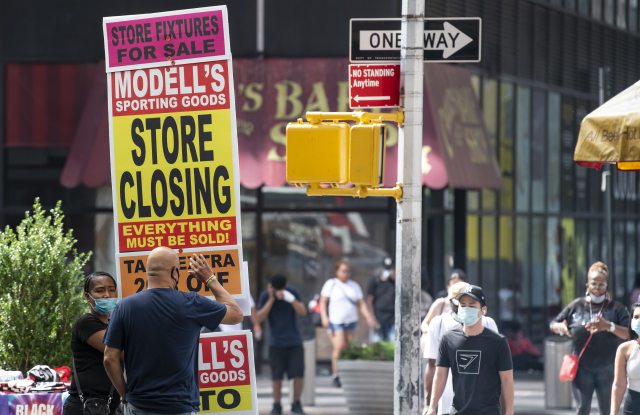Vendor Business Strategies to Offset Impact of Retail Bankruptcies – WWD
Even before the COVID-19 pandemic rattled the retail industry, the sector was on the ropes for a variety of reasons — mostly having to do with how and where shoppers shop.
As a result, retail saw more than 85 bankruptcies since 2015, according to data from CB Insights. When the pandemic struck, another two dozen retailers filed for Chapter 11 as consumers settled into “lockdown” mode, shopping online for only the bare essentials as they weathered the outbreak.
As stores reopened earlier this summer, there wasn’t enough foot traffic to sustain many retail brands — and more companies filed for bankruptcy protection.
For secured lenders of bankrupt businesses, there’s a good chance they’ll get some, if not all, of their money back as the company reorganizes. For unsecured debt such as money owed to a supplier, it’s a different story. If the vendor is big enough, it’s possible for the parties to negotiate an agreement and new terms — especially if that brand or retailer depends on that vendor to drive sales.
For smaller suppliers and vendors as well as contract-based workers, it is highly likely they will ever get paid in full or even partially — which could drive these small businesses into their own failure. But there are tactics and business strategies that could help mitigate some of the risk and protect a business. First, industry experts say “knowledge is power,” noting that it’s important to understand the larger context of the market and the macroeconomic forces impacting consumer behavior and sales. Second, it is critical to leverage various financial tools to help mitigate risk. And third, industry experts urge small businesses to “know the retailer” and have a clear understanding of their balance sheet and financial health.
Regarding the larger context, looking at the retailers and brands that filed for bankruptcy protection last month revealed data showing the impact of the coronavirus on business as stores were forced to close. For example, G-Star Inc.’s top unsecured debt was for its lease obligations and landlords. For Ascena Retail Holdings Inc., which listed estimated total liabilities of between $1 billion and $10 billion, the top unsecured creditor was Simon Properties Group with $31.6 million followed by Brookfield Properties with $16.6 million owed and then Boston Properties Ltd. with a tab worth $8.8 million.
But the bulk of unsecured credit for Ascena was for trade debt. And there were a lot of vendors impacted as the retailer listed in its court filing that the estimated number of total unsecured creditors was “more than 100,000.”
John Doyle, managing director of Deloitte Financial Advisory Services LLP, told WWD that with “all of the uncertainty in the market, vendors and providers need to manage service and relationships while placing a notable focus on their financial health and debt levels.”
“There are many technical strategies to this that range from matching value received to value shipped, agreements on payables and carefully managing aging and delinquent receivables,” Doyle explained. “Relationships matter, and teams need to be honest and transparent on payment needs, payment timing, etc.”
Aside from retailers shuttering stores, the financial markets are also creating added pressure for vendors and suppliers. And this is leading companies to tap into financial instruments to help reduce risk.
“In the wake of the numerous retail bankruptcies being announced, the credit markets are undergoing dramatic changes and many of them have had to significantly restrict their coverage, causing a void in this specialized market,” Michael Stanley, managing director at Rosenthal & Rosenthal told WWD. “This tightening of the credit market has triggered a resurgence of factoring requests. It’s an age-old financial model but right now, it’s an invaluable tool for companies because it offers vendors many of the immediate solutions they need like larger credit lines and working capital financing against receivables to support extended terms or delayed payments from retailers.”
Stanley said in the current environment, “factoring is one of the best commercial bargains out there and it’s a very viable solution for vendors because it allows them to mitigate risk and secure the best credit terms they can in a very challenging market.”
A customer leaves a Pier 1 retail store, which is going out of business, during the coronavirus pandemic.
AP Photo/Lynne Sladky
One industry source from a leading research firm that works with both suppliers and retailers told WWD that the “challenge for vendors is that they are paying money to source, manufacture and deliver before they themselves get paid.”
“In the current environment, there are several ways vendors can better protect themselves, although of course there are never any guarantees,” the source said. “First of all, know your retailers, know their balance sheets. If you’re risk-averse, diversify. If you’re worried that you’re dealing with a retailer who may file for bankruptcy, wait until after the filing to work with them. If you’re working with them when they’re on the precipice of bankruptcy, you’ll get pennies on the dollar, should they file. If you wait until after, you’ll get dollar for dollar, albeit it might take a while to collect.”
The source also suggested vendors “think about shortening the payment terms, take payments in smaller increments, even get cash on delivery. If you can get pre-paid, even better. To the extent possible, deal with essential retailers. Finally, create a direct-to-consumer strategy. And if you weren’t thinking of working with Amazon, say a year ago, it’s time to think about working with them now.”
For more retail business news, see:
As Weekly Retail Sales Sink, Online Maintains Momentum
Kentucky, Idaho Top List of Fastest Unemployment Recovering
Social Movements, Economic Inequality Spotlight Need for Policy Change


:quality(70)/cloudfront-eu-central-1.images.arcpublishing.com/businessoffashion/EVDKNX5IQVEO7NFOBXUTQOVU5I.jpg)
:quality(70):focal(523x147:533x157)/cloudfront-eu-central-1.images.arcpublishing.com/businessoffashion/RRX4SA5FAVDOPEJ2QUT35EGAVY.jpg)
:quality(70):focal(670x314:680x324)/cloudfront-eu-central-1.images.arcpublishing.com/businessoffashion/YAYTKA3MARHGVKK4B4H5ARS7I4.jpg)
